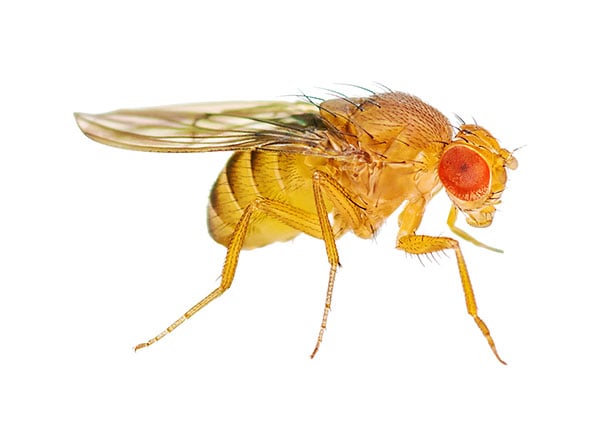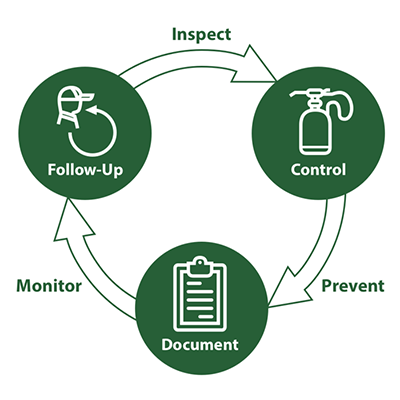Fruit Fly Pest Control
Appearance And Behavior
Fruit flies (also called small flies, pomace flies or vinegar flies) are usually dull brownish or tan in color, often with red eyes and a striped pattern on the abdomen. They are between 1/10” and 1/8” long. Their cream-colored larvae reach a length of about 1/5” before pupating and becoming adult flies.
Fruit flies lay their eggs in any fermenting liquid. This might be found in overripe fruit, spilled sweet liquids such as beer or soda syrup; rotting potatoes, onions or other vegetables; a dirty, wet mop; or scum in a stagnant drain. Fruit flies also breed in or around recycling bins, or in the recycled cans and bottles themselves.
Some other areas which might offer ideal conditions for fruit flies to lay eggs include cracks of tile floors that are constantly wet, especially if the grout is missing or damaged; along and underneath commercial beverage lines; in the bottom of trash cans; and in mops and mop closets.

Fruit flies, in general, do not bite and are harmless to humans. However, they do frequent unsanitary areas and there is evidence that fruit flies can carry pathogenic bacteria as a result.
Fruit Fly Prevention

All the insecticides in the world cannot solve a small fly problem without good sanitation. Small flies are almost always due to a sanitation problem. In persistently wet areas where good sanitation is hard to achieve, we can apply a special cleaning product called Bio Foam. Bio Foam contains bacterial cultures that digest the scum in which small flies breed. Applications of Bio Foam can be supplemented by the use of Bio Cleaner, a mop-water detergent that contains, in addition to other cleaning agents, the same bacterial cultures as Bio Foam.
Many folks use the tried, and true, home remedy involving putting vinegar in a jar and attracting the fruit flies to die in the jar. It’s true that this attracts the flies, but it doesn’t get to the root of the problem or to the eggs that haven’t hatched yet. The key to controlling fruit flies is to find and remove the material in which the flies are laying eggs and feeding.
- Check mop sinks, dishwasher sinks, drains, and other fixtures to make sure food residues that might have spilled or splashed into them are thoroughly cleaned away.
- Waste receptacles of every kind should be washed out at least once a week – even if disposable liners are used (small amounts of liquid residue can leak through these into the can bottom).
- Clean up all spills as soon as they are noticed.
- Fruit and vegetables should be kept in a cool area, with proper stock rotation to ensure that they don’t become rotten. Never place fresh fruit or vegetables on top of old stock in a bin.
- If can and bottle recycling is practiced, wash these out before placing them in recycling bins. Empty recycling bins daily and wash them out at least once a week.
- Wash and rinse floor mops after each use and hang up to dry.
- Keep all drains running freely.
- Maintain tiled floors in exposed-food areas in good condition so that liquid spillage cannot seep behind or beneath them.
Fruit Fly Control Process
Identification - First, we will identify the flies in question to ensure they are in-fact fruit flies.
Inspection - We will complete an inspection, preferably in the morning before lights are turned on. At this time of day, many fruit fly adults will be near their breeding source. Later, after people have arrived and lights are on, the flies will disperse and be found just about anywhere.
Meet with the decision maker - Our technician will consult with you to recommend necessary improvements made to the places in which larvae and pupae were actually found.
Use of insecticides - It may not be necessary to apply any insecticides on our first visit, but supplemental application to the breeding areas may be necessary. Bio-foam may also be recommended.
Follow-up - Your technician will schedule a routine follow-up, usually in a week to inspect fly populations.

Fruit Fly Control With Plunkett's
At Plunkett’s, our goal is to help you quickly, conveniently, and in the most cost-effective way. We make every effort to be with you asap, usually within a day or two.
Learn More
There are a good number of flying insects that are particularly likely to make pests of themselves around your home. Some of the most common examples of flying insects Plunkett’s encounters frequently include:






